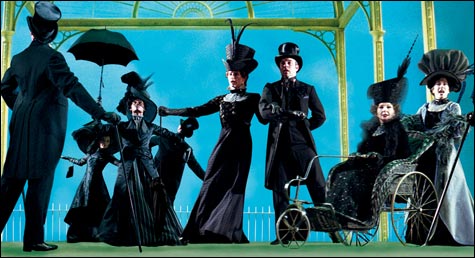
ASCOT GAVOTTE Cecil Beaton’s costumes were inspired by the “Black Ascot” of 1910. |
Those for whom My Fair Lady without Rex Harrison and Julie Andrews or Audrey Hepburn just isn’t My Fair Lady should probably skip the 2001 Cameron Mackintosh/National Theatre revival that landed at the Opera House last Wednesday in favor of the 1956 original show soundtrack or the 1964 film (with Marni Nixon singing most of Eliza Doolittle’s songs). Everyone else can expect to have an enjoyable evening, if not to be transported back to the Golden Age of Broadway. This new production is a little callow and a little obvious, and, especially in Matthew Bourne’s choreography, it seems to want a bigger stage than the Opera House affords. But in Lisa O’Hare it has a gamine Eliza who’s learned most of the right things from Andrews and Hepburn, and in Christopher Cazenove and Tim Jerome a plausible Professor Henry Higgins and Alfred P. Doolittle, respectively. The revival even puts Marni Nixon — who sang for Natalie Wood in the 1961 film of West Side Story as well as for Hepburn — on stage as Professor Higgins’s mother.
One could hardly quibble with the sets, which re-create the arcade of Covent Garden’s old vegetable market, Professor Higgins’s crammed two-story study/library, the Georgian exterior of Wimpole Street, and Mrs. Higgins’s conservatory; we even see, flying past, Covent Garden Piazza’s St. Paul’s Church (designed by Inigo Jones) and, as Alfred P. strives to get to the church on time, what looks like Alfred Gilbert’s statue of Eros in Piccadilly Circus. (Ascot, the Red Lion Pub in Tottenham Court Road, and the ballroom of the unidentified Embassy are left largely to your imagination.) The costumes are sumptuous, right down to original designer Cecil Beaton’s black-and-white Ascot (inspired by the “Black Ascot” of 1910, when England was in mourning for Edward VII). The men in Bourne’s arch Ascot number prance about and shake their well-formed legs; the women, whether at the Embassy ball or in the East End of Alfred P.’s pre-nuptial pub crawl, do less. (This is, after all, the Matthew Bourne who gave us the male-swan Swan Lake.)

O’Hare is most successful in the first act, her cockney flower seller brimming over with a self-confidence that gets Professor Higgins’s attention. O’Hare will go rubber-legged at times, almost like Lucille Ball, or she’ll look wide-eyed at the audience while leaning away from one of Higgins’s idle threats. Her accent never falters, and her voice is as strong and clear as Bow bells. On occasion, with the connivance of the upbeat-to-a-fault orchestra, she does undercut Frederick Loewe’s glorious melodies in the name of “styling” — “Someone’s ’ead restin’ on my knee,” for one. But she is “deliciously low,” and she does “scrub up real nice.” With proper pronunciation comes petulance, however, and she’s all but undone by the whiny dialogue with the professor in his mother’s conservatory.
Christopher Cazenove is a disconcertingly sturdy Higgins — shouldn’t a man obsessed with his life’s work have a lean and hungry look? — and without Rex Harrison’s cartoonish, larger-than-life outrageousness, he comes across as a self-absorbed, garden-variety misogynist. His singing can have power and feeling, but it’s also apt to take refuge in a kind of sprechstimme. “I’ve Grown Accustomed to Her Face,” which Harrison voiced lightly, just sounds off-key, and you don’t hear Higgins realizing that his true love is Eliza and not Colonel Pickering or himself. Tim Jerome, who looks a little like Jack Warden, brings plenty of personality and a public-house voice to Alfred P., but he’s sillier and cruder and less complex than the original Doolittle, Stanley Holloway. That’s also true of Justin Bohon’s Freddy, who might as well be called “Naive Young Man.” His singing is another puzzle: he has the pipes for his one number, “On the Street Where You Live,” but he keeps cutting off the lines (the last word of “Just to know you are near” snapped into “neah!”), as if he were trying to prove this musical is still hip. Walter Charles’s Pickering is a riot in his “Rain in Spain” flamenco attempt (while Eliza and Higgins engage in an impromptu tango) and on the phone with Scotland Yard and the Home Office; he doesn’t have much of a military bearing, however.
And the staging could have a lighter hand. The Ascot black is “explained” by preceding scenelet in which a newspaper hawker tells us the king has just died — so when Higgins shows up at the race course in his usual business suit, he seems not just absent-minded but grossly insensitive. As for Eliza, she arrives in a fashionable dress and with what looks like a flying saucer pinned to the side of her head. Maybe Higgins and Pickering have no clue about ladies’ hats, but Eliza would know better. Neither was there any need to pin her in an upstage corner when Higgins and Pickering are forming their mutual admiration society after the ball; we know they’re ignoring her. It all comes to a smug climax with Eliza and Higgins facing off after he’s demanded his slippers, arms folded, glaring at each other, before they both start laughing. Was a little more romance too much to expect for a show that’ll be here for Valentine’s Day?